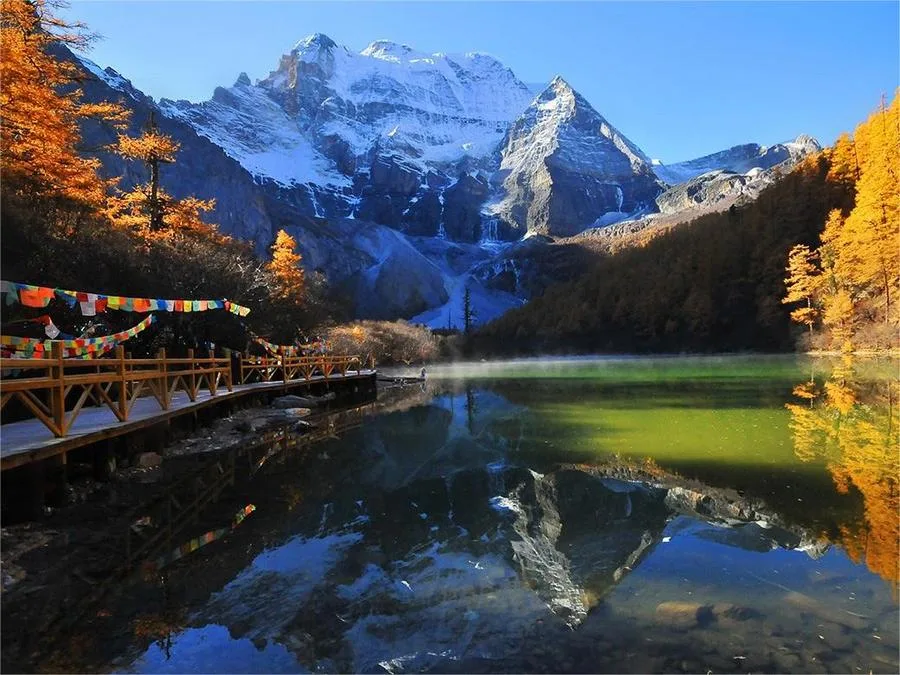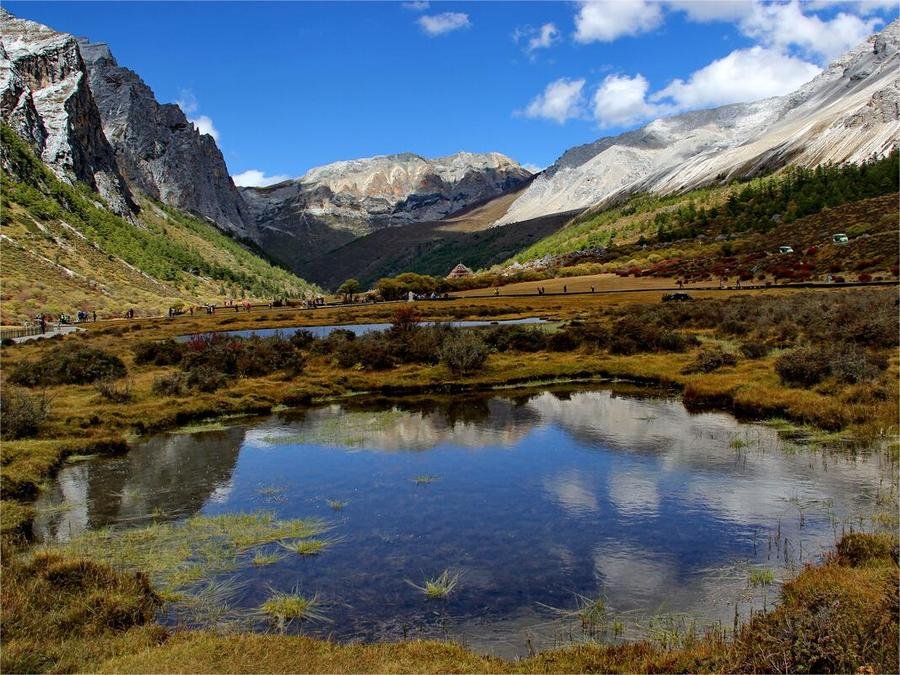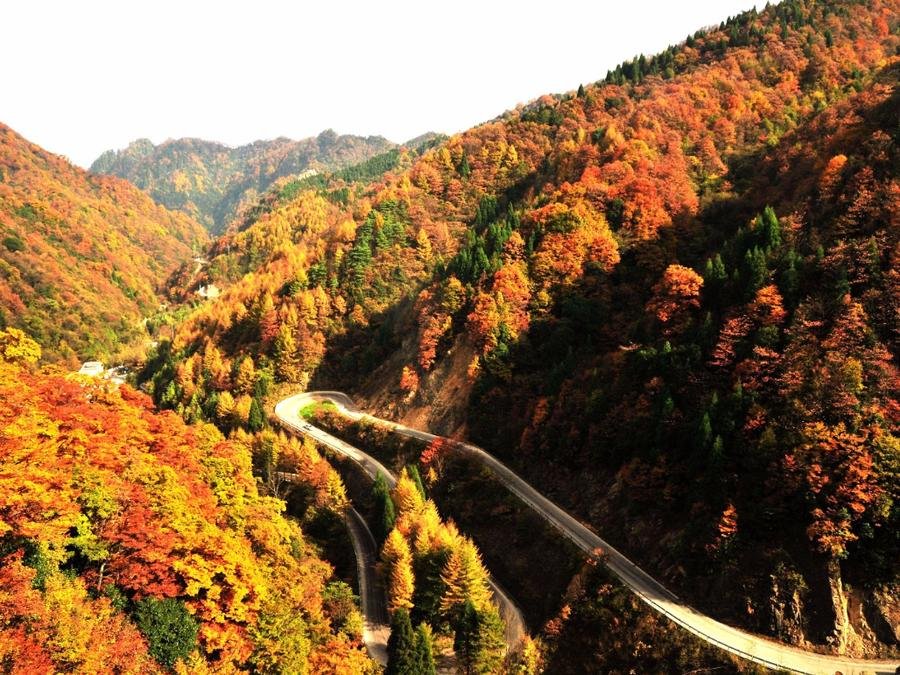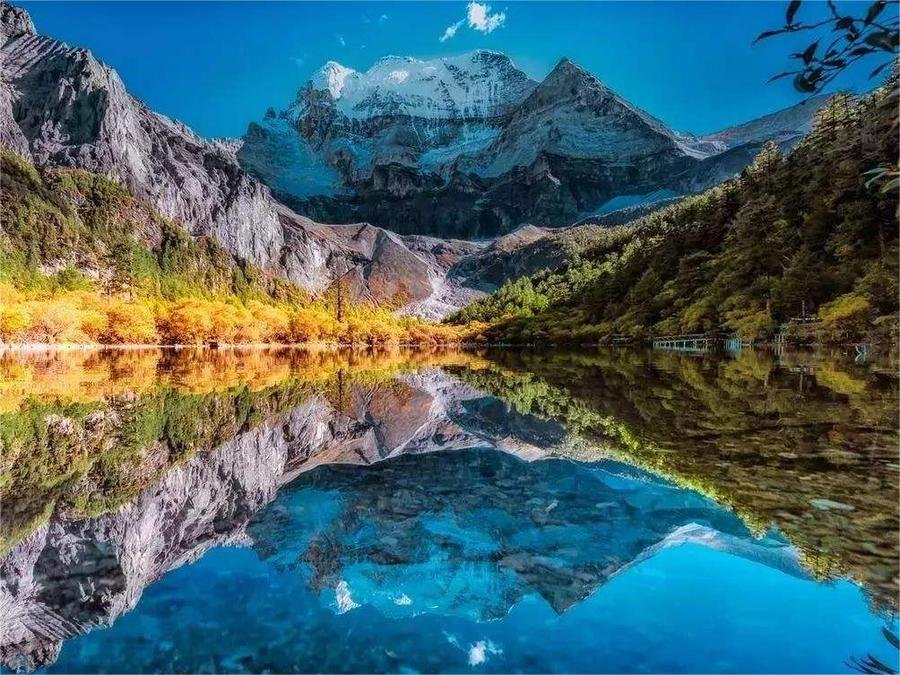Yading Nature Reserve (亚丁自然保护区) is a breathtaking sanctuary nestled in the heart of the Sichuan Province, China. Spanning over 1,300 square kilometers, this pristine wilderness is a haven of natural beauty and cultural significance. Towering snow-capped peaks, including the iconic Chenresig and Jampelyang, dominate the landscape, creating a stunning backdrop for serene alpine meadows, crystal-clear lakes, and cascading waterfalls.
Home to diverse flora and fauna, Yading Nature Reserve is a sanctuary for rare and endangered species, including the elusive snow leopard and the vulnerable Yunnan golden monkey. The region’s unique blend of Tibetan culture and religious heritage adds an enchanting element to the experience, with ancient monasteries and sacred sites dotting the area.
Visitors can embark on exhilarating trekking trails that lead to panoramic viewpoints, immersing themselves in the untouched wilderness and spiritual atmosphere. Yading Nature Reserve offers a harmonious blend of natural wonders and cultural significance, making it a must-visit destination for nature enthusiasts, adventure seekers, and those seeking a profound connection with the natural world.
Table of Contents
- Basic Information
- Location and Transportation
- Highlights of Yading Nature Reserve
- Xiannairi Sacred Mountain (仙乃日)
- Yangmaiyong Sacred Mountain (央迈勇)
- Xianuoduoji Sacred Mountain (夏诺多吉)
- Mengzi Grand Canyon (蒙自大峡谷)
- Echu Mountain (俄初山)
- Axi Alpine Park (阿西高山公园)
- Luorong Pasture (洛绒牛场)
- Milk Lake (牛奶海)
- Chonggu Monastery (冲古寺)
- Pearl Lake (珍珠海)
- Kasi Hell Valley (卡斯地狱谷)
- Yading Village (亚丁村)
- Five-Color Lake (五色海)
- Vlog about Yading Nature Reserve
- Useful Tips from Reviews
Basic Information
| Website | https://cn.yadingtour.com/ |
| Estimated Length of Tour | 1 – 2 days |
| Ticket Price | 146 RMB (1st April – 30th Novmber) 120 RMB (1st December – 31st March) |
| Sight-seeing Bus | 120 RMB |
| Opening Hours | 7.00 – 19.00; Last admission: 16.40 (1st April – 30th November) 8.20 – 18.00; Last admission: 15.50 (1st December – 31st March the next year) |
| Telephone Number | 0086-0836-6966022 |
Location and Transportation
Yading Nature Reserve is located in the southwestern part of China, specifically in the Daocheng County of the Garze Tibetan Autonomous Prefecture in Sichuan Province. Nestled within the eastern Himalayas and adjacent to the Tibet Autonomous Region, the reserve is renowned for its stunning alpine landscapes, snow-capped peaks, lush valleys, and pristine lakes. The region’s geographical coordinates are approximately between 28.6167° N latitude and 100.2686° E longitude.
Tourists from other cities can first fly to Daocheng Yading Airport (稻城亚丁机场) and then transfer to a coach to cover the remaining 150 kilometers, which normally takes nearly four hours (best time to visit Yading Nature Reserve).
Highlights of Yading Nature Reserve
Xiannairi Sacred Mountain (仙乃日)

Xiannairi, meaning “Bodhisattva of Compassion” in Tibetan, is the highest of the three sacred peaks, standing at an impressive 6032 meters. This mountain is considered to embody the form of Avalokitesvara, the Bodhisattva of Compassion, who is depicted sitting on a lotus platform, holding a treasure vase, and arriving on a cloud. The peak is perpetually covered in snow, giving it a majestic and serene appearance. The mountain’s grandeur is best appreciated from Pearl Lake, a tranquil body of water that is said to be the mirror of a celestial maiden.
Xiannairi’s peak resembles a reclining Buddha, resting serenely within a lotus. The sight of the mountain bathed in sunlight, often described as glowing golden, is a breathtaking experience. Its sheer elevation and spiritual significance make Xiannairi a pilgrimage destination for many Buddhists, as well as a major attraction for nature lovers and hikers.
Yangmaiyong Sacred Mountain (央迈勇)

Yangmaiyong, which translates to “Bodhisattva of Wisdom” in Tibetan, is the southern peak of the “Three Guardian Kings” mountains and stands at 5958 meters. In Buddhist iconography, Manjushri is the embodiment of wisdom, and Yangmaiyong’s sharp, crystal-like peak is said to represent the Bodhisattva’s wisdom sword pointing towards the heavens.
Surrounded by vast valleys, dense forests, verdant meadows, and clear streams, Yangmaiyong’s stunning landscape is reminiscent of an untouched paradise. The peak itself, with its pristine white snow and commanding presence, appears as a serene and noble figure, embodying purity and tranquility. The view from the base of the mountain, looking up at its sheer walls and sharp summit, is awe-inspiring and often leaves visitors in silent reverence.
Xianuoduoji Sacred Mountain (夏诺多吉)

Xianuoduoji, also known as Chanadorje in Tibetan, represents the Bodhisattva Vajrapani (the Bodhisattva of Wrath and Protection). Standing at 5958 meters, Xianuoduoji is the eastern peak of the “Three Guardian Kings” mountains, ranking third among them in Buddhist cosmology. The mountain’s towering presence symbolizes the Bodhisattva’s fierce resolve to protect and bring justice. Its sharp, imposing peak is reminiscent of a bat poised to take flight, an imagery used by explorer Joseph Rock, who likened it to a thunder god from Greek mythology.
The surrounding landscape adds to the mystical allure of Xianuoduoji. To the left of the mountain lies the green marble peak known as the Wealth God, and to the right is the Horsehead Vajra. Below the Horsehead Vajra is the “Danxia landform forest,” home to 800 arhats. At the foot of Xianuoduoji lies the Luorong Pasture, a site where Joseph Rock once camped. This pasture offers a sweeping view of the majestic peak and serves as a base for trekkers and pilgrims.
Mengzi Grand Canyon (蒙自大峡谷)

Mengzi Grand Canyon, stretching 13 kilometers between Riwa and Mengzi, is a geological marvel with its steep, towering cliffs and dynamic weather patterns. The canyon’s rugged beauty is amplified by the swirling mists and the roaring river that carves through its depths. The cliffs on either side of the canyon are adorned with natural formations that resemble various animals, each accompanied by rich mythological and folkloric narratives, breathing life into the rocks and inspiring endless imagination.
The canyon is home to the “Yao Rong Mountain,” the local land deity of Wage Village, depicted as a figure dressed in white and riding a white steed. The mountain rises straight into the clouds like a colossal pillar, its smooth and precipitous cliffs enhancing its majestic presence. On the opposite vertical rock face, natural formations resembling stone monkeys can be found, each with unique and lifelike appearances.
Echu Mountain (俄初山)

Echu Mountain, known as “the glittering mountain” in Tibetan, rises to an elevation of 5145 meters. It is located in the northern part of the Yading Nature Reserve, near the edge of the Gongga Mountain range, and is approximately 25 kilometers from Riwa Township. Echu Mountain is often likened to a beautiful fairy sitting gracefully among the clouds. The southern part of the mountain features high alpine gorges, while the northern part consists of the Echu Canyon, which cradles charming, gently sloping villages.
The area around Echu Mountain is lush with vegetation, particularly in the Ramgerlin District, which is the largest forested area in Daocheng. Every October, Echu Mountain’s scenery becomes mesmerizing. As the first frost descends upon its ridges and valleys, the forests below the snow line don vibrant autumn hues. At this time, Echu Mountain resembles a bride awaiting her wedding, adorned in a holy khata (a traditional ceremonial scarf) and dressed in colorful autumn attire. From the summit of Echu Mountain, the views of the three sacred mountains of Yading are truly spectacular.
Axi Alpine Park (阿西高山公园)

Axi Alpine Park, whose name means “good place” in Tibetan, is located 6.2 kilometers from the Gongling area. Visitors to Axi Alpine Park can experience the rustic and genuine Tibetan village life, observe the traditional process of Axi pottery making, and visit the historic site of the Axi Battle.
The park features expansive meadows adorned with lush grasses and vibrant wildflowers. Vast forests of alpine cypress trees stand tall and green, interspersed with the striking red hues of the “Three Trees” species. Rhododendrons bloom brilliantly, creating a picturesque and inviting landscape. Crystal-clear rivers meander through the park, with the majestic Three Guardian Kings Snow Mountains visible in the distance. The natural beauty of this area is complemented by cultural symbols such as mani stone piles and colorful prayer flags. The harmonious coexistence of people and nature here adds to the park’s ethereal charm, making it feel like a heavenly paradise.
Luorong Pasture (洛绒牛场)

Luorong Pasture, perched at an elevation of 4,150 meters, is one of the most renowned spots within Yading Nature Reserve. This expansive alpine meadow, used by local Tibetan herders for grazing livestock, is framed by the awe-inspiring peaks of the three sacred mountains: Chenresig (Xiannairi), Jampayang (Yangmaiyong), and Chenadorje (Xialuoduoji). It is the ideal location to view these majestic snow-capped mountains, providing a breathtaking backdrop to the tranquil pastures.
During spring and summer, the meadow bursts into a riot of colors as wildflowers bloom across the undulating hills, creating a stunning and vibrant landscape. The Gongga River meanders through the pasture, where herds of yaks, sheep, and horses graze peacefully, presenting a scene of pastoral harmony. This serene environment is not only a paradise for nature lovers but also a haven for photographers and trekkers who often camp here to capture the magical sunrise and sunset over the sacred peaks.
Luorong Pasture also holds historical significance as it was once a campsite for the famous American botanist and explorer Joseph Rock during his explorations of Yading. Today, it continues to be a favored spot for those seeking to immerse themselves in the pristine beauty of the natural world.
Milk Lake (牛奶海)

Milk Lake, also known as Luorong Co, is another gem of the Yading Nature Reserve. Nestled at the foot of the magnificent Jampayang (Yangmaiyong) peak, this glacial lake sits at an elevation of 4,600 meters. Milk Lake gets its name from the milky white ring that encircles its bright blue waters, a result of mineral deposits and glacial runoff.
Surrounded by towering snow-capped mountains, Milk Lake’s waters exhibit a stunning palette of colors. The shallow edges of the lake appear dark due to the accumulation of ancient plant sediments. Moving further in, the water transitions to a light green band before deepening to a vibrant turquoise at its center. When sunlight illuminates the still surface, the lake glistens like a precious gemstone, offering a surreal and mesmerizing sight.
Milk Lake is considered a holy site in the region, drawing pilgrims and visitors who are captivated by its otherworldly beauty. The hike to Milk Lake, although challenging due to the high altitude, rewards trekkers with unparalleled views and a sense of profound tranquility.
Chonggu Monastery (冲古寺)

Chonggu Monastery, situated at the base of the majestic Chenresig (Xiannairi) Mountain, sits at an elevation of 3,880 meters. Although the original structure has suffered significant damage over the years, leaving behind only ruins, it remains a site of great spiritual and historical significance. The monastery is affiliated with Gongga Langjiling Monastery and houses a statue of Shakyamuni Buddha in its prayer hall, where monks chant and offer prayers.
The monastery’s location is unparalleled within the Yading Nature Reserve. From Chonggu Monastery, visitors are treated to stunning views of the three sacred mountains, perpetually covered in snow, and the lush meadows adorned with wildflowers at their feet. Behind the monastery lies the formidable Yading Gorge. This picturesque setting, with the monastery serving as a gateway to the sacred Shambhala Kingdom, creates a sense of otherworldly serenity.
In 1928, the famous American botanist and explorer Joseph Rock stayed at Chonggu Monastery for three days during his explorations. From the monastery’s windows, he gazed out at the tranquil Yading village under the moonlight, which later inspired James Hilton’s description of the idyllic “Blue Moon Valley” in his novel “Lost Horizon.”
Pearl Lake (珍珠海)

Pearl Lake, known as Zhuomalacuo in Tibetan, is often described as a “green gem at the foot of the snow mountain.” This small alpine lake, located near Chonggu Monastery, is renowned for its mesmerizing emerald green waters. Surrounded by dense foliage and reflecting the snow-capped peaks, Pearl Lake presents a captivating and serene landscape.
The lake’s unique beauty is best appreciated in person, as it’s difficult to capture its vibrant and pristine green hue through descriptions alone. The clear, mirror-like waters create a perfect reflection of the surrounding scenery, making the lake appear almost otherworldly. Visitors can walk along the boardwalk around the lake, taking in the stunning views and basking in the tranquility of the setting. The radiant sunlight warms the area around the lake even though the snow atop the mountains remains brilliantly white, creating a striking contrast.
Sitting by the lake, one is enveloped by the peaceful ambiance, with the only sounds being the gentle rustling of the leaves and the distant murmur of the wind. The breathtaking natural beauty, coupled with the spiritual significance of the area, leaves a lasting impression on all who visit. This moment of serenity, with the eternal presence of the snow-capped peaks and the clear waters of the lake, offers a profound sense of timelessness.
Kasi Hell Valley (卡斯地狱谷)

Kasi Hell Valley, located on the western side of Yangmaiyong Snow Mountain, is a remarkable and awe-inspiring natural wonder within the Yading Nature Reserve. Stretching 12 kilometers from Kasi Village in the south to the southern slopes of Xiannairi in the east, the valley is renowned for its dramatic and precipitous cliffs, which create a sense of thrilling adventure and eerie beauty.
The valley is named “Hell Valley” due to its distinctive rock formations, which resemble various infernal scenes such as the Ghost Cliff, Hell Gate, and Yama’s Palace. These formations are vividly lifelike, with weathered white limestone at the end of the valley taking on the shapes of guillotines, knives, and spears, reminiscent of descriptions of tortures in hell. This unique and otherworldly landscape is one of the eight cold forests (corpse forests) mentioned in Tibetan Buddhism, considered a crucial passage for the soul’s journey from the mortal world to paradise.
Traversing through Hell Valley is indeed a formidable challenge, symbolically representing a passage through trials and tribulations. Those who endure the arduous journey are rewarded with the breathtaking sight of the three sacred mountains: Yangmaiyong, Xiannairi, and Xianuoduoji. These mountains stand as sentinels at the valley’s end, embodying the essence of paradise and offering a profound sense of achievement and spiritual fulfillment to those who reach them.
Yading Village (亚丁村)

Yading Village, located 34 kilometers from Shangri-La Town, is the namesake of the Yading Nature Reserve and is often referred to as “the last Shangri-La.” Nestled between towering snow-capped mountains and dense forests, the village emerges suddenly, almost miraculously, as if it did not exist until the moment it comes into view.
Perched on a mountain terrace within the valley, Yading Village offers a surreal sense of timelessness and seclusion. The surrounding landscape features rugged, dark mountain ranges that stand out starkly against the deep blue sky. At the valley’s end, the imposing Xiannairi Snow Peak is bathed in sunlight, its sharp, simple lines creating a striking silhouette that evokes both majesty and tranquility.
The village comprises 28 households, with traditional Tibetan houses seemingly placed at random yet harmoniously blending with the natural environment. Each home appears to be meticulously designed to complement the surrounding landscape, reflecting a deep connection between the inhabitants and their environment. This unique arrangement enhances the village’s charm and underscores the sense of living in harmony with nature.
Five-Color Lake (五色海)

Five-Color Lake, known as Mudicuo in Tibetan, is a mesmerizing highlight of Yading Nature Reserve. Nestled at an altitude of 4,500 meters, it is situated above Milk Lake, between the sacred peaks of Xiannairi and Yangmaiyong. The lake’s name comes from its unique ability to reflect five distinct colors when sunlight illuminates its crystal-clear waters. This natural phenomenon creates a stunning, multicolored spectacle that captivates all who visit.
The lake’s nearly circular shape and pristine waters make it a breathtaking sight, especially when viewed from the steep slope to the right of Milk Lake. Revered as a sacred lake by locals, Wuse Lake holds significant spiritual importance. It is believed to possess mystical properties, capable of revealing historical events and predicting the future. Buddhist scriptures highly praise Wuse Lake, comparing its beauty and spiritual value to that of Tibet’s renowned Yamdrok Lake.
Vlog about Yading Nature Reserve
Useful Tips from Reviews
Long Route (Approximately 8 hours):
- Start from the ticket office.
- Take a 70-minute sightseeing bus to Zharu Monastery.
- Visit Zharu Monastery and Chonggu Temple.
- Continue to Luorong Cattle Ranch.
- Take a horse ride to Shesengya (Note: Limited horse ride tickets before 9 am).
- Explore Milk Lake (Surrounded by snow-capped mountains).
- Visit Five-Color Lake (Before 3 pm, a famous holy lake for worship and wishes).
Short Route (Approximately 3 hours):
- Begin at the tourist center.
- Take a bus to Zharu Monastery.
- Visit Zharu Monastery and Chonggu Temple.
- Explore Pearl Lake (Panoramic views from the foot to the top of the mountain).
Transportation Tips:
- The bus journey takes about 1 hour. Those prone to motion sickness should take anti-motion sickness medication in advance.
- Suggest sitting on the left side when going uphill and on the right side when going downhill.
Climbing Tips:
- Climb at a steady pace and be cautious of mild symptoms like chest tightness or shortness of breath.
- Oxygen should be taken promptly if experiencing such symptoms, especially to avoid difficulties during the descent.
Wildlife Caution:
- The area has various small animals (🐒). Do not feed them arbitrarily.
Sun Protection:
- Strong UV radiation at the mountaintop; apply sunscreen.
Accommodation Guide:
- Daocheng County: Close to Daocheng Yading Airport, well-equipped but high altitude and potentially challenging for sleep. Prices may be relatively high.
- Shangri-La Town: Popular choice due to proximity, variety of hotel options, and lower altitude, making it convenient for Yading exploration.
- Yading Scenic Area: High altitude, which could be challenging for those not acclimated to high altitudes. Stunning views of snow-capped mountains from the windows.

